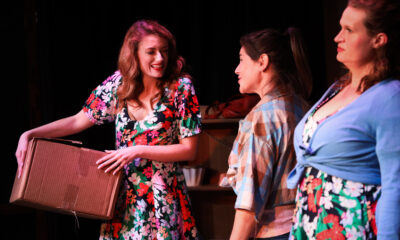Create
Vintage Pinellas: Bob Dylan’s TV special
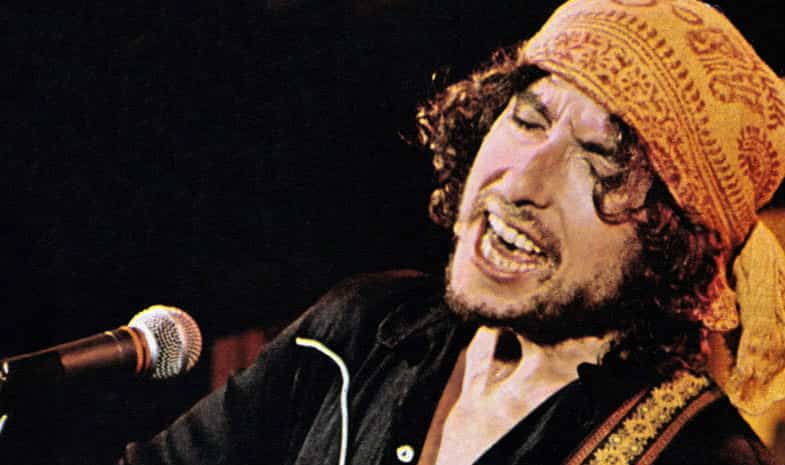

“Mr. Tambourine Man,” Belleview Biltmore, April 22, 1976. NBC
So Bob Dylan sold the publishing on his extensive song catalog. Was anyone surprised?
In all of popular music, no artist has ever been more enigmatic or unpredictable than Dylan. The peerless singer/songwriter is also shrouded in a mystique that’s served him well over the decades. No one has his number; no one knows why he says what he says and does what he does.
On April 22, 1976, during the second round of cross-country touring with his now-legendary Rolling Thunder Revue, Dylan videotaped his first – and to date only – television special.
And he taped it at the Belleview Biltmore Hotel, in the tiny Pinellas County town of Belleair, just a rolling stone’s throw from downtown Clearwater.
With Joan Baez and Roger McGuinn along for the ride, Dylan and his ragtag backing band (which included violinist Scarlet Rivera and guitarist T-Bone Burnett) played two sets on that Thursday, each close to three hours long, for an invited audience of about 100 for each performance.
The producer was Burt Sugarman, whose Midnight Special was currently the reigning music show on TV.
“Both the network and some of his people came to me, and said they’d seen work that I’d done, and would I want to do this show?” Sugarman told the Catalyst. “It was never intended as a Midnight Special.”
Although a fuzzy copy of the fully edited, untitled program exists, it’s never been on DVD or a streaming service.
In fact, it never aired on TV at all.
Sugarman, even after 44 years, remains tight-lipped. “Can’t discuss it,” he said. “You’d have to ask him. He saw the finished product, and he wasn’t happy. Was it his voice? Was it this, or was it that, I don’t know. He decided it, he picked the songs and whatever he did at the end of the day he just wasn’t happy. And if you look at his history, you’ll see that more often than not.”

Whatever the artist’s deal with NBC was, he honored it – in a typically Dylan way. In September, NBC aired a Bob Dylan special called Hard Rain, taped just a month after Clearwater at an actual Rolling Thunder concert, outdoors in the daylight in Fort Collins, Colorado.
Reviews were scathing. As seen on YouTube today, Hard Rain is badly shot, poorly edited and – worst of all – the end-of-the-tour performance is lethargic.
To date, this second version has never been made available, either. Just like its predecessor, it vanished into the shadows and straight up Bob Dylan’s mystique.
A timeline
April 12: Dylan, his band and crew arrive at the Belleview Biltmore, an historic structure built by Henry Plant in the 1890s. The Rolling Thunder Revue tour will begin on the 18th in Lakeland, with subsequent shows in Tampa and St. Petersburg, and then caravan around the country. Set up in the Starlight Ballroom, tour rehearsals will continue night and day until the first show, at the Lakeland Civic Center.
Burt Sugarman: “He wanted it shot at that exact location. I believe he told me that it was the largest wood structure in the world.”
April 20 and 21: Just before the public concerts started at, respectively, St. Petersburg’s Bayfront Center and Tampa’s Curtis Hixon Hall, a smiling man strolls through the audience handing out scraps of colored paper.
Kathy Gold Shoemaker was at the Bayfront show, with her then-husband Bob, on the 20th : “People were milling around before the concert started. We were on the floor, about 25 rows back. When I got back from the bathroom, Shoe said ‘Look what I got!’ He said ‘Some guy was walking around just giving out these tickets to a special show that Bob’s doing at the Belleview Biltmore. He gave me one.’ And I said ‘Well, I want one too! I’m not going to let you go to that without me.’ So I chased the guy down and he gave me a ticket, too.”
This reporter, who was at the concert that Tuesday with the Shoemakers, also tracked down the ticket-man. Nowhere on the paper did it say “Bob Dylan,” just the location, the date and the time. But we all knew it was something cool. We all knew.
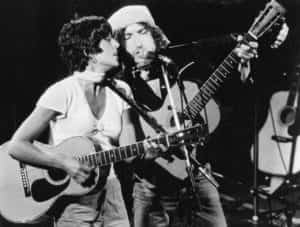
“I Dreamed I Saw St. Augustine,” Belleview Biltmore, April 22, 1976. NBC
April 22: Shoemaker: “It was morning. We stood around the hotel in a parking lot area on the backside for quite some time. And we saw all of the principal players milling around. I specifically remember seeing Roger McGuinn. We were all starstruck. But once we got into the hall they said ‘Once you come in, you can’t leave. There’s not going to be any in-and-out.”
The stage, surrounded on three sides by two levels of scaffolding, took up half of the ballroom floor. We were led inside, in a neat and orderly line, and up the stairs to the second level. Kathy and Bob were seated (“With our arms and legs hanging over the scaffolding”), but there was no space left for my girlfriend and I. Every spectator in that room was being carefully placed like a piece of furniture for the cameras.
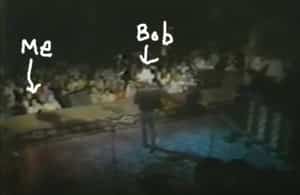
Close proximity
We were led back down to the bottom level, and instructed to sit on the massive Asian rug that covered the floor – at the very front of the stage. When Dylan came out, solo, and played “Mr. Tambourine Man,” his harmonica spit landed on my arm. That’s how close we were.
Faded memories: Dylan did not speak a word the whole time, except to introduce Baez, who joined him for “Blowing in the Wind,” “I Dreamed I Saw St. Augustine” and a couple of others. During his solo performance of “Don’t Think Twice, It’s Alright” he seemed to forget the words, stopped, and ran back to his amplifier, upon which rested a book I recognized as Writings and Drawings By Bob Dylan. I watched him find the page and refresh himself on the lyrics. Then he played the entire song again.
I was 17 years old, and this was the first time I’d ever heard the haunting “Visions of Johanna,” which is now one of my favorite songs, by anyone. He played the whole thing two times for the cameras.
Shoemaker: “There was lots of waiting around between songs. It wasn’t like a show. They would come out and sing a song, and start again, and stop again, and people would come and go on the stage. It wasn’t like a concert. Probably because it was filming.”
In Behind the Shades, drummer Howie Wyeth told writer Clinton Haylin: “The rehearsals sucked at that place … it just wasn’t happening. Then we did the (Clearwater concerts) and they were filming it and it happened. That was the first day that the music started feeling right again. Bob did a really hip version of ‘Like a Rolling Stone.’ He did some tunes that he hadn’t done at all.”
“At the end,” said Kathy Gold Shoemaker, “we were really, really hungry, because we weren’t able to leave except to go to the bathroom. We got something to eat on the way home, whatever road that was. That’s pretty much all I remember, ‘cause we were smoking weed.”
At the second taping that evening, Dylan and company stormed through an electric set that included “Isis,” “Lay Lady Lay” and a dozen others.
“It was a great disappointment the Dylan show never aired,” associate producer Jaques Andre would say later, “because the lighting was beautiful, the composition was wonderful and the music was absolutely sensational. It was Dylan at his best. It had a nice feeling because it was simple. It presented the music simply and it wasn’t pretentious at all.”
The end result
No one seems to be sure when or why Dylan nixed the whole thing. Obsessives have speculated that their boy didn’t care for the scaffolding, which gave the show a sort of mid ‘60s Hullabaloo look.
That was not the case, Sugarman said. “Everything that happened, he wanted. There wasn’t anything that he didn’t want. I want Joan Baez on the show, says he. Burt says, that’s terrific. just great. How many numbers are you guys gonna do together? The answer was ‘Don’t know – we’ll wait till we see.’ Nobody works that way.
“She’s a terrific lady, by the way, and she went along with those things. You just did what he wanted to do.”
As for Dylan, “He was always a gentleman – nice to be with, nice to talk to. Never any issues.”
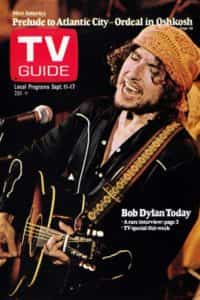 Ironically, when the September broadcast of Hard Rain, the Colorado version, was just weeks away, the country’s media received the usual stack of promotional photographs to run – all from the aborted Belleview Biltmore taping, with no explanation.
Ironically, when the September broadcast of Hard Rain, the Colorado version, was just weeks away, the country’s media received the usual stack of promotional photographs to run – all from the aborted Belleview Biltmore taping, with no explanation.
Dylan even appeared on the cover of TV Guide. The full-color photo was also from the Biltmore.
So who owns the “lost” Belleview Biltmore footage? Sugarman, who retired many years ago, doesn’t know. All he knows is that it isn’t him.
“You’re seeking an answer on something that really doesn’t have an answer,” he said. “It doesn’t exist. If you asked Dylan now what it was and all that, I would doubt if he knew, or remembered.
“The truth is: I got paid. I did the best I could. I liked it. And I can’t ask for any more.”






